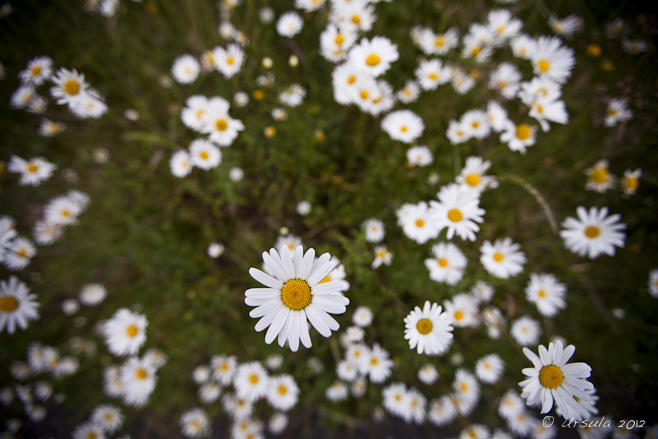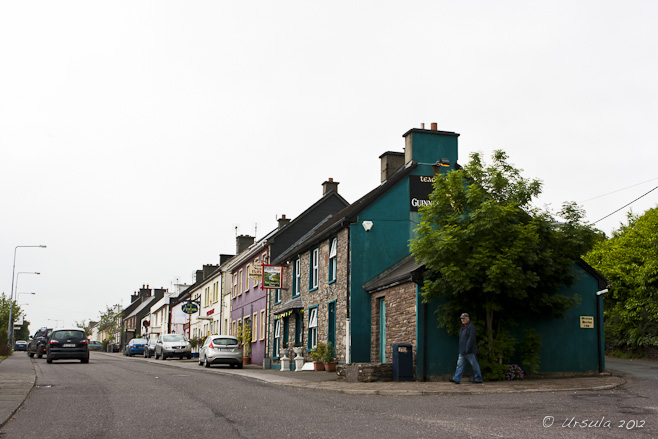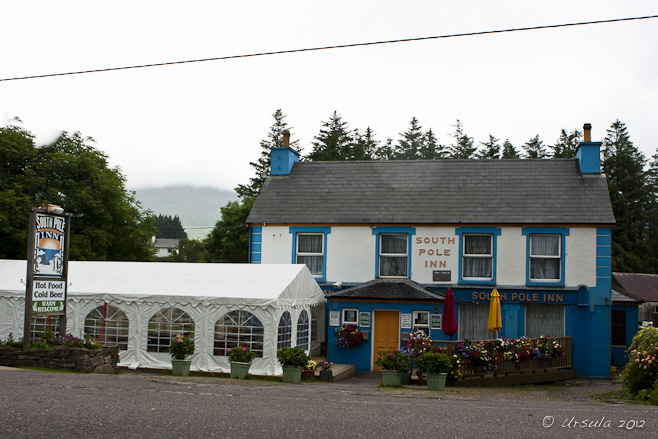
Daisies on the green.
We looked out the windows of our accommodation at Annascaul, on the southwest tip of Ireland, and although the sky was heavy and overcast, we hoped it might not rain…
We were not half a block out the door, when our hopes were dashed: rain, drizzle, fog, mist; our day was beset with precipitation of all sorts. Although the the Gulf Stream is supposed to warm the Dingle Peninsula, I was not convinced as we started our walk from Annascaul to Dingle, shivering in our raincoats.

Main Street (only street?) Annascaul, including our accommodation, The Anchor.
Distance: 22km/13.7 miles, Ascent: 430 m/1290 ft

The South Pole Inn was originally opened by Annascaul’s famous son, Antarctic explorer Tom Crean (1877-1938), after his retirement from the British Royal Navy.

Ireland’s religious roots are in early Celtic Christianity. As a consequence, Madonas and crucifixes are less commonly seen outside churches here than in many other Catholic countries.

Another day walking in Ireland: mist, green, and sheep.

A dappled gray pony is a nice change from the ubiquitous sheep!

If Irish council workers were stopped by rain, they’d never get anything done. These two are cutting back the brambles on the narrow road verges.

A donkey and a skewbald pony watch our passing.

Cottage ruins often seem to be left where they stand.

Descending through the mist and rain into Kilmurray Bay, with the remains of the Minard Castle, built in the mid-16th century by the Fitzgerald’s and destroyed by Cromwell in 1650, perched on the hill.

“A stolen ringbuoy – a stolen life.” Kilmurray Bay

The beach at Kilmurry Bay is framed by rounded boulders thrown up by the sea. The ruins of the Minard Castle tower (fenced off with “Keep Out” warning signs) stand on the hillside.

A small creek runs into Kilmurry Bay from in front of the Minard Castle ruins.

Wet and wild: Buttercups and fuchsia counterpoint the ever-present greens.
Eventually, Lispole village came into view, but it soon became clear that unless we were to deviate from the country road we were on, we would not actually go through it. So, we took advantage of our packed sandwiches and a short break in the rain to have a quick lunch perched on the roadside before heading off up hill again.

A Gothic church in the village of Lispole is set amid green hills and mist.

A wooden door on an old stone shed is almost hidden by grass, creepers and ivy.

Foxgloves give a splash of colour.

View over Short Strand and the hills of Dingle Peninsula.
It was one of those days: whether it was the cold, the damp or our tiredness I don’t know, but our walking route never seemed to quite match our notes. We never saw the Ogham stone that was meant to be in an ancient graveyard (not the first one we missed, either); we didn’t find the “arrow painted on the roof of the turf shed” that was meant to be a way marker; and we didn’t see the point at which we were meant to have two walking options. Fortunately, we ended up on the one we wanted by default, passing the 18th century Garfinny Bridge before finally coming into Dingle.

Called “the rainbow bridge” because of its shape, the pretty Garfinny Bridge arches over the Garfinny RIver.

Built in the 18th century without the use of mortar, the Garfinny Bridge is the last of these bridges standing in Ireland.

Coming into John St., DIngle.
 And, as always, the cold, the wet and the fatigue were quickly forgotten over a pint and a plate of fresh fish and chips at the local pub.
And, as always, the cold, the wet and the fatigue were quickly forgotten over a pint and a plate of fresh fish and chips at the local pub.
Sláinte!
Photos: 21June2012
























.png)


Love it, you guys amaze me…
😀